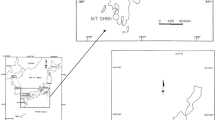Abstract
Loess paleosols have been often studied to reconstruct late Quaternary past climate changes. In the present study, textural analysis, TOC, CaCO3 content, micromorphology and clay mineralogy of the three loess paleosol profiles from three sites (Choori, Alochibagh and Burzahama), from Kashmir valley are presented. Based on the dates of Burzahama section, the exposed loess paleosols are approximately dated to 45ka. Textural analyses suggest that the sediments are largely fine silt followed by silty loam and silty clay loam. The fine sand component in the loess and paleosols indicate that winds in the valley were strong, but in phases the wind velocity was low. The paleosols are much thicker than loess layers and form several horizons within the lithosections. The increase of CaCO3 content indicates that it has leached in phases and along with total organic carbon (TOC) resulted in mild pedogenesis with variations in the rate of pedogenesis within the paleosols and forming pedocomplexes. Micromorphology of the loess-paleosols indicates the presence of calcite nodules with iron oxide coating indicating sub-aerial weathering and pedogenesis. The presence of channel structures in loess paleosols formed due to root traces and pores probably during the warmer periods. The replacement of chlorite by smectite clays in loess paleosols suggests that the alteration of clay minerals probably took place in cold, dry, warmer climatic conditions in low wind regime.
Similar content being viewed by others
References
Agrawal, D. P., Dodia, R., Kotlia, B. S., Razdan, H. and Sahni, A. (1989) The Plio-Pleistocene geologic and climatic records of the Kashmir Valley, India: a review and new data. Palaeogeo. Palaeoclimat. Palaeoeco., v.73, pp.267–286.
Aoubi S, Jalalian A, Eghbal MK, Khademi H. (2002) Identification and genesis of clay mineral in two paleosol from Sepahanshahr (Isfahan) and Emam Gheis (Charmahal-Bakhtiari). Iranian Jour. Crystallo. Mineral., v.10, pp.157–178.
Babeesh, C., Achyuthan, H., Jaiswal, M.K., Lone, A. (2017) Late Quaternary loess-like paleosols and pedocomplexes, geochemistry, provenance and source area weathering, Manasbal, Kashmir Valley, India. Geomorphology, v.284, pp.191–205.
Bronger, A. and Heinkele, T. (1989) Micromorphology and genesis of paleosols in the Luochuan loess section, China: pedostratigraphic and environmental implications. Geoderma, v.45, pp.123–143.
Buggle, B., Glaser, B., Hambach, U., Gerasimenko, N., Markovic, S.B. (2011) An evaluationof geochemical weathering indices in loess-paleosol studies. Quaternary Internat., v.240, pp. 12–21.
Dar, R.A., Romshoo, S.A., Chandra, R., Ahmad, I. (2014) Tectono-geomorphic study of the Karewa Basin of Kashmir Valley. Jour. Asian Earth Sci., v.92, pp.143–156.
Emadi, M., Baghernejad, M., Memarian Hamidreza, H., Saffari, M. and Fathi, M. (2008) Genesis and clay mineralogical investigation of highly calcareous soils in semi-arid regions of southern Iran. Jour. Appld. Sci., v.8, pp.288–294.
Fedoroff, N., Courty, M. A. (1987) Morphology and distribution of textural features in arid and semiarid regions. Association Francaise pour l’Etude du Sol, Plaisir, pp. 213–219.
Han, J.M. (1982) A preliminary study on the clay mineralogy of the loess at Luochuan section. Quaternary Geology and Environment of China. Beijing: China Ocean Press.
Kemp, R.A. (1995) Distribution and genesis of calciticpedofeatures within a rapidly aggrading loess-paleosolsequence in China. Geoderma, v.65, pp.303–316.
Kusumgar, S., Agrawal, D.P., Krishnamurthy, R.V. (1980) Studies on the loess deposits of the Kashmir Valley and Dating. Radiocarbon, v.22, pp.757–762.
Liu, T.S. (1985) Loess and the Environment. Ocean Press, Beijing, pp 251.
Meenakshi, Pankaj Kumar, Shrivastava, J. P., Sharma, R. (2018) High resolution 14C AMS ages (<50 ka) of organic matter associated with the loess-paleosol Holocene-Late Pleistocene (8–130 ka) sediments of Dilpur Formation, Karewa Group, Kashmir, India. Quaternary Geochrono., v.47, pp.170–179.
Miller, B. A. and Schaetzl, R. J. (2011) Precision of Soil Particle Size Analysis using Laser Diffractometry. Pedology, v.76, pp.1719–1727.
Motamed A. (1998) Quaterner, Tehran University Press. 310 p. (In Persian)
Muhs, D.R., Ager, T.A., Skipp, G., Beann, J., Budahn, J., McGeehin, J.P. (2008) Paleoclimatic significance of chemical weathering in loess-derived paleosols of Subarctic Central Alaska. Arctic, Antarctic and Alpine Res., v.40. 396–411.
Rousseau, D. D., Derbyshire, E., Antoine, P. and Hatte, C. (2007) Europe. Elsevier B.V., 2 pp.1440–1456.
Rowell, D.L. (1994) Soil Science: methods and applications. Harlow, Longman Scientific and Technical.
Singhvi, A.K., Bronger, A., Pant, R.K. and Sauer, W. (1987) Thermoluminescence dating and its implications for the chronostratigraphy of loess-paleosol sequences in the Kashmir Valley, India. Chemical Geol., v.65, pp.45–56.
Walkley, A. and I. A. Black. (1934) An examination of Degtjareff method for determining soil organic matter and a proposed modification of the chromic acid titration method. Soil Science, v.37, pp.29–37.
Zarate, M.A., Kemp, R.A., Espinosa, M. and Ferrero, L. (2000) Pedosedimentary and paleoenvironmental significance of a Holocene alluvial sequence in the southern Pampas, Argentina. The Holocene, v.10, pp.481–488.
Zhang, Q., Huang, J., Hu, F., Huo, N., Shang, Y., Chang, W. and Zhao, S. (2018) The distribution of organic carbon fractions in a typical loesspaleosol profile and its palaeoenvironmental significance. doi: https://doi.org/10.7717/peerj.4611.
Zhengtang, G., Fedoroff, N. and Dongsheng, L. (1996) Micromorphology of the loess paleosols sequence of the last130ka China and Paleoclimatic events. Science in China, v.39, pp.468–477.
Acknowledgement
Asif Ali is grateful of Anna University, Chennai, for Anna Centenary Research Fellowship (ACRF) that enabled him to carry out this work. The authors are also very thankful to anonymous reviewers for their constructive comments and suggestions that helped in the presentation of the data and improvement of the text.
Author information
Authors and Affiliations
Corresponding author
Rights and permissions
About this article
Cite this article
Ali, A., Achyuthan, H. & Azhardin, M. Clay Minerals and Micromorphology of the Loess Paleosols, Kashmir Valley, India. J Geol Soc India 94, 275–280 (2019). https://doi.org/10.1007/s12594-019-1307-5
Received:
Accepted:
Published:
Issue Date:
DOI: https://doi.org/10.1007/s12594-019-1307-5




